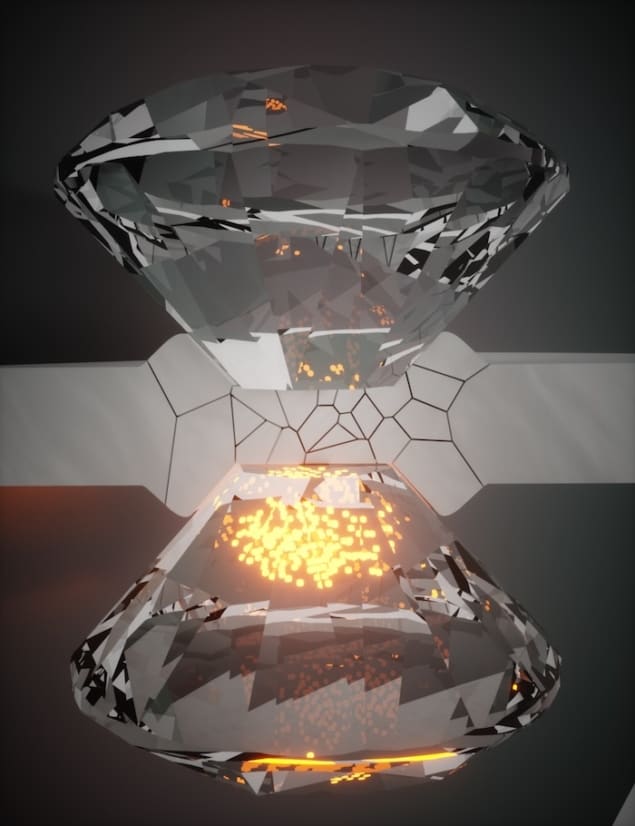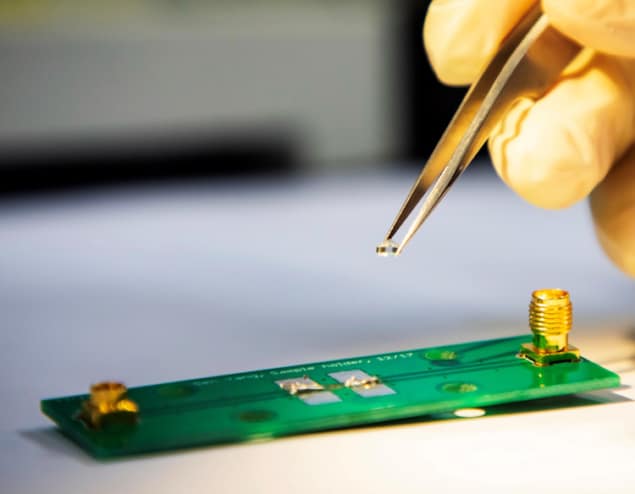
Quantum sensors based on nitrogen vacancy (NV) colour centres in diamond can be used to probe the magnetic and structural properties of materials at extreme pressures. This is the finding of three independent research teams reporting their work in Science last week.
In the past, high-pressure experiments have provided important insights into how materials behave under the crushing forces in the Earth’s mantle, improving our comprehension of earthquakes. Scientists have also used high-pressure techniques to explore pressure-induced magnetism and investigate new materials with superior physical properties such as extreme hardness. Recently, researchers even discovered near-room temperature superconductivity in hydride materials that are compressed to more than 106 atmospheres.
The anvil cell
The main way to study materials under such great pressures is to use millimetre-sized anvil cells made from diamond or minerals such as moissanite. These work by squeezing a sample between the flattened tips of two pieces of very hard material. The small size of the tips makes it possible to reach pressures of more than 400 GPa or 4 x 106 atmospheres with only small applied forces.
The main problem with such measurements is that the samples – which are typically tiny, at just tens of microns across – need to be contained in a bulky pressure vessel. This set-up drastically limits the type of measurements that can be performed. Sensitive measurements of magnetization, for example, are difficult because the magnetism of the anvil cell is thousands of times greater than that of the sample itself.
NV colour centres as probes
The three research teams have now overcome this problem by using a defect in diamond, known as the NV colour centre, as a magnetic-field probe. These centres, which act like tiny quantum magnets with different spins, occur when two neighbouring carbon atoms in diamond are replaced by a nitrogen atom and an empty lattice site. When excited with laser pulses, the fluorescent signal emitted by the centres can be used to monitor weak local magnetic changes in a nearby sample. This is because the intensity of the emitted NV centre signal changes with the local magnetic field.

One of the three teams, led by Sen Yang and Swee K Goh of the Chinese University of Hong Kong, dispersed diamond particles containing NVs onto their sample (an iron-pnictide superconductor with the chemical formula BaFe2(As0.59P0.41)2) before placing it in a moissanite anvil cell. Thanks to the material’s spin-dependent fluorescence rate, and the fact that it is transparent, the researchers were able to measure the electron spin resonance (ESR) spectra of the NV centre optically. They then used this spectral measurement to determine the magnetic field of the sample with a sensitivity approaching microtesla.
The Hong Kong team also determined the superconducting transition temperature (Tc) of their sample. At temperatures above the Tc, the magnetic field felt by the NV centre is the same as the applied magnetic field. When a sample of superconducting material is cooled below Tc, however, it begins to repel an applied magnetic field – a phenomenon known as the Meissner effect. This superconductivity-induced expulsion of the magnetic field from the sample alters the field profile near the surface of the material, creating effects that are “felt” by the NV centres on the sample surface. The researchers derive the Tc through careful analysis of the field distribution, using the NV centres to sense both the magnitude and direction of the magnetic field at high spatial resolution.
Embedding NVs in a diamond anvil cell
The other two teams, led by Norman Yao of the University of California, Berkeley, US and Jean-François Roch of France’s Ecole Normale Supérieure (ENS) Paris-Saclay, employ a slightly different approach. These researchers embed their NV-containing diamond particles directly into the anvil cell, which is also made of diamond.
Yao and colleagues prepared a thin (50 nm) layer of the defects a few nanometres below the surface of the pressure chamber on which their sample of iron and gadolinium is positioned. The researchers then shone a green laser on the defects. By measuring the resulting fluorescence, they monitored weak local magnetic changes in the sample in the same way as Yang and Goh’s team did. Next, they reconstructed an image of the NV response to produce a spatially-resolved map of the magnetic field emanating from the sample. They use this information to determine the sample’s magnetic dipole moment. When they repeat the experiment at different pressures and temperatures, they find that the dipole moment changes abruptly, which corresponds to a magnetic phase transition in the sample.
New kind of sensing protocol
The lead author of the Berkeley group’s study, Satcher Hsieh, says that their technique is new because instead of measuring a static magnetic signature, it relies on measuring magnetic “noise” emanating from the sample. Such noise arises because electrons in a metal are free to move around, and their motion generates a fluctuating magnetic field that the sensor can identify. Depending on whether the magnetic phase is ordered or disordered, the electrons may scatter off the spins with different amplitudes, and this changes the amplitude of the fluctuating field. “In our work, we measure a common magnetic transition (paramagnetic to ferromagnetic), but in the long term we hope to use this technique to identify more exotic magnetic phases,” Hsieh says.
The Berkeley team’s approach is also the first to measure all six components of the stress tensor at high pressures. As such, Hsieh says it may help further our understanding of high-pressure phase transitions that are driven by shear stresses, as is often the case for minerals found deep inside planets.
In-situ quantum sensors
Meanwhile, Roch and colleagues at ENS Paris-Saclay used a similar technique to image how the magnetization of an iron bead evolves as pressures of up to 30 GPa are applied. In their work, they imaged the magnetic field profile of an iron pellet undergoing a magnetic phase transition between the (ferromagnetic) alpha crystal structure and the (non-ferromagnetic) epsilon crystal structure, which occurs at around 15 GPa. They also imaged a magnesium boride (MgB2) sample as it crossed its superconducting transition state (at 7 GPa) by detecting the Meissner effect.

Roch explains that integrating NV centres into the diamond anvil itself means that his group’s quantum sensors are in direct contact with the sample being tested. This approach allows the researchers to probe the materials’ magnetic properties as well as strain despite the minute size of the sample. It will also enable them to measure phenomena such as pressure-induced high-spin low-spin magnetic ordering and the superconductivity of novel superconductors (like the hydride materials H3S and LaH10) with unprecedented accuracy and resolution, he says.
Strongly correlated electron systems
Members of the Hong Kong team say they are now using their technique to study various strongly-correlated electron systems under high pressure. For instance, they are investigating how superconducting systems behave while simultaneously using pressure to tune the strength of electron-electron correlations.
The Berkeley and ENS Paris-Saclay teams, for their part, say they would like to study materials like the high-pressure hydrides, which become superconducting at just 10 degrees below room temperature. “Our group is now also measuring phase transitions of the magnetic minerals present in Mars’ crust to better understand Martian magnetism,” Hsieh says. The group is also studying the magnetic properties of a new iron-bismuth compound that was recently synthesized under high pressure.
Towards higher pressures and larger sample sizes
Roch and his colleagues point out that it would be interesting to investigate ways of detecting the onset of superconductivity by optical means at even higher pressures. Extending their work to pressures of greater than 100 GPa would be a challenge, since the spin readout contrast of the NV centres dramatically reduces at pressures above 60 GPa. They suggest that this problem might be solved by engineering NVs via controlled nitrogen doping during the (plasma-assisted) growth of the diamond layer or by laser writing the NVs. These fabrication processes can bury a thin sheet of NV centres at a depth at which strain in the anvil might be less damaging.
Yao’s group also is pursuing higher-pressure studies, but with a somewhat different approach. “We are trying to excite the NV centres using a different colour excitation laser, which we think may provide sufficient energy to extend their use to 100 GPa and beyond,” explains Hseih.

Diamond quantum sensor breaks new record
The three groups agree that their different techniques are complementary, offering powerful new ways of probing matter at extreme pressures. Such techniques could be extended to atomic diamond defects other than NV centres, such silicon-vacancy centres, or indeed defects in materials other than diamond. Some examples include the optically active defects present in moissanite (6H silicon carbide), which can be manufactured at centimetre or larger scales — unlike diamond anvils, which are just millimetres across. Such defects could thus be used to study larger sample sizes.
According to Roch, the NV probes might also be coupled to X-ray beamlines, such as those in synchrotron facilities, in the future. This would make it possible to image samples at even smaller spatial resolutions – far below 100 nm for 4th-generation synchrotrons, for example. The X-ray diffraction patterns obtained could unambiguously identify the material being probed in the anvil cell. Combining the high spatial resolution with the magnetic images from the NV “magnetic microscopes” is likely to lead to new discoveries in the properties of high-pressure materials, he says.
“All three sets of results clearly demonstrate that this is only the beginning for NV probes and high-pressure physics studies,” he tells Physics World. “It is a very exciting time.”



